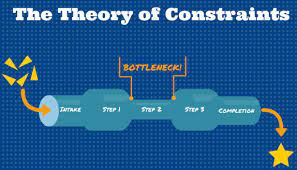The theory of constraints is a management philosophy and methodology that was developed by Dr. Eliyahu M. Goldratt in the 1980s. The theory of constraints provides a framework for identifying and managing constraints in a system, with the aim of improving overall system performance. In this blog post, we'll explore the theory of constraints and its key concepts.
What are constraints?
Constraints are any factors that limit the performance of a
system. They can be physical, such as a machine that has a limited capacity, or
they can be organizational, such as a policy or procedure that slows down the
system. Constraints can be internal or external to the system, and they can
change over time.
The five steps of the theory of constraints
The theory of constraints consists of five steps that
organizations can follow to improve their performance:
Step 1: Identify the constraint The first step is to
identify the constraint in the system. This involves analyzing the system and
identifying the point where performance is limited.
Step 2: Exploit the constraint The second step is to exploit
the constraint by maximizing its use. This involves ensuring that the
constraint is working at full capacity and is not being underutilized.
Step 3: Subordinate everything to the constraint The third
step is to subordinate everything to the constraint. This involves aligning all
other activities in the system to support the performance of the constraint.
Step 4: Elevate the constraint The fourth step is to elevate
the constraint by removing any barriers that limit its performance. This can
involve investing in new technology, changing policies or procedures, or
redesigning the system.
Step 5: Repeat the process The fifth step is to repeat the
process by identifying the new constraint in the system and starting the
process again.
Benefits of the theory of constraints
The theory of constraints provides a framework for
organizations to identify and manage constraints in their systems, leading to
improved performance and increased profitability. By focusing on the
constraint, organizations can achieve significant improvements in their
processes and achieve competitive advantage.
The theory of constraints provides a powerful approach to
improving system performance by identifying and managing constraints. By
following the five steps of the theory of constraints, organizations can
achieve continuous improvement and drive success.

Comments
Post a Comment